M.4 A-3 E8
the "Easy Eight"
![]()

In 1944 the M.4 "Sherman" medium tank was going to reach the top of its development. The need to supply plants for the ever increasing tank production required the reorganization of productive layouts, standardization of components, and adoption of engines which could be produced rapidly and in large quantities.
This latter was achieved with the adoption of the powerful and reliable liquid-cooled V-8 Ford engine.
|
Medium
Tank M4A3 E8 Weight : 33.7 ton |
The M.4 A-3 E8 detailed data are the following :
ARMOR
Type : Turret, cast homogeneous steel; Hull, rolled and cast homogeneous
steel; Welded assembly
| Hull Thickness | Actual | Angle w/vertical |
| Front, upper | 2.5 inches | 47 degrees |
| Front, lower | 4.25 to 2.0 inches | 0 to 56 degrees |
| Sides | 1.5 inches | 0 degrees |
| Rear | 1.5 inches | 10 to 22 degrees |
| Top | 0.75 inches | 83 to 90 degrees |
| Floor, front | 1.0 inches | 90 degrees |
| Floor, rear | 0.5 inches | 90 degrees |
Turret Thickness |
Actual | Angle w/vertical |
| Gun shield | 3.5 inches | 0 degrees |
| Front | 2.5 inches | 40 to 45 degrees |
| Sides | 2.5 inches | 0 to 13 degrees |
| Rear | 2.5 inches | 0 degrees |
| Top | 1.0 inches | 90 degrees |
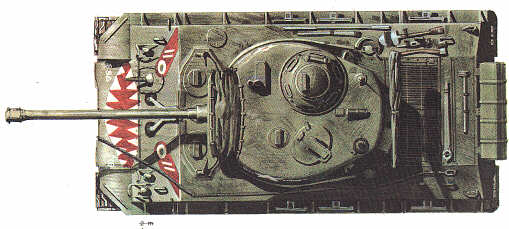
By the Summer of 1943, the list of required modifications for the Shermans, resulting from
battle experience as well as from development and test programs, had greatly increased.
Among the improvements the wet stowage for ammunition was adopted for
reducing the risk of fire in case the tank was hit on the less armored sides (ammo was normally dry stowed in the tank sponsons).
On the 75mm and 76mm tanks the ammunition was relocatd from the sponsons to water protected racks below the turret. Ten boxes on the hull floor held 100 75mm round and required 37.1 gallons of water. An additional gallon protected the 4 round ready stack on the turret floor. In the 76mm gun tanks, the ammunition also was located on the hull floor with 30 rounds on one side of the drive shaft and 35 on the other. These containers held a total of 34.5 gallons of water. The 6 ready rounds were carried in a box on the turret floor filled with another 2.1 gallons. To prevent freezing during cold weather, water solutions of ethylene glycol were frequently used in wet stowage racks, while corrosion inibitors (e.g: Ammudamp) were added to water to avoid problems with rust.
The major improvement, however, was that involving the complete redesign of the tank's suspensions. Battle experience had proved in fact the short life of the original vertical volute spring suspension of the late models M3s (see beside) due to the tank's increasing weight (bigger guns required bigger turrets, etc.) and to the need of larger tracks. |
|
|
In response to these requirements a new horizontal suspension was developed : the Horizontal Volute Spring Suspension (or HVSS). One of its advantages was that when the horizontal volute springs were placed in compression by either the front or rear bogie wheel arm, the load was transmitted to the opposite arm thus keeping tension on the track. |
The new suspension adoption increased the weight of the tank by approximately 2950 pounds with the T66 track or by approximately 4780 pounds with the heavier T80 track.
The American experimental designs were identified as E8. The M.4 tanks equipped with the new HVSS were, therefore, nicknamed "Easy Eight". Its main armament, as said, was a powerful 76mm gun capable of delivering an AP round at a 780 mt/sec. muzzle speed (piercing capacity 101 mm at 1,000 yds) or firing at maximum distance of approximaly 15,000 yards.
![]()
Production started in the first months of 1944 and continued through April 1945. The "Super Sherman" M.4 A-3 E8 became the standard tank of the 3rd and 7th US Armies in Europe. Although it could not compete on a One-on-One basis neither with the big German tanks (Panthers and Tigers) nor, if that had been the case, with the new T34-85s, its technical realibilty and adequate armament, coupled with the US Army magnificent logistic organization and unlimited supplying capacities, guaranteed the M.4 A-3 E8 a prolonged, honourable life. It bravely soldiered in Korea as well as in the Middle East and equipped, in the post-war years, many Western allied armies.
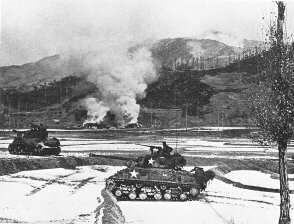
|
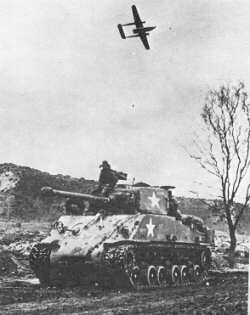 Above and left : M.4 A-3 E8s deployed during Korean War |
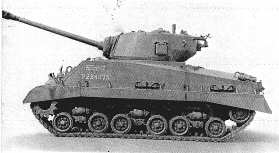 |
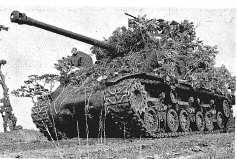 |
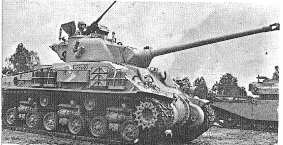 |
M.4 A-3 E8 soldiering under the colors of the
British (left, top), Japanese (above) and
Israelian (left, bottom) armies. The Israelian tank mounts both
turret and 75mm gun of French production as well as additional armored plates.
|
![]()
![]() Please forward your comments (if any) to my Mailbox
Please forward your comments (if any) to my Mailbox
![]()
![]() Back to Klisura 69 homepage
Back to Klisura 69 homepage
Page established on : September 5, 1998
Last update : September 5, 1998
This page is maintained by Mario Paesani .....the webmaster !
This page hosted by ![]() Get your own Free
Home Page
Get your own Free
Home Page